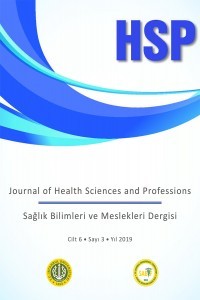Nöromusküler Hastalıklarda Solunum Fonksiyonlarının Değerlendirilmesi: Derleme
Nöromusküler hastalıklar, solunum, solunumsal değerlendirme
-
Neuromuscular diseases, respiration, respiratory assessment,
___
- Rochester DF, Esau SA. Assessment of ventilatory function in patients with neuromuscular disease. Clin Chest Med 1994;15(4):751-763.
- Bertorini TE. Introduction: Evaluation of patients with Neuromuscular Disorders. In: Bertorini TE editors. Neuromuscular Disorders: Treatment and Management. 1st ed. Philadelphia: Saunders; 3-19; 2010.
- LS Aboussouan. Mechanisms of exercise limitation and pulmonary rehabilitation for patients with neuromuscular disease. Chron Respir Dis 2009 6: 231.
- Polkey MI, Lyall RA, Moxham J, Leigh PN. Respiratory aspects of neurological disease. J Neurol Neurosurg Psychiatry 1999;66:5-15.
- Bourke SC. Respiratory involvement in neuromuscular disease. Clin Med 2014;14 (1):72-75.
- Perrin C, Unterborn JN, Ambrosio CD, Hill NS. Pulmonary complications of chronic neuromuscular diseases and their management. Muscle Nerve 2004;29:5-27.
- Ambrosino N, Carpene N, Gherardi M. Chronic respiratory care for neuromuscular diseases in adults. Eur Respir J 2009;34:444–451.
- Dogan T, Kendirli MT, Togrol E. [Neuromuscular assessment of respiratory system function]. Solunum sistemi fonksiyonlarının nöromusküler degerlendirmesi. İcinde: [Functional assessment of respiratory system: Current approaches and clinical usage]. Solunum Sistemi Fonksiyonel Degerlendirmesi Güncel Yaklasımlar ve Klinikte Kullanımı. Ed. Kartaloglu Z, Okutan O. Birinci baskı, Deomed, İstanbul; 81-101, 2013.
- Kartaloğlu Z, Okutan O. [Current approach to respiratory problem in neuromuscular diseases]. Nöromusküler hastalıklardaki solunumsal problemlere güncel yaklaşım. Tuberk Toraks 2012;60(3):279-290.
- Yeldan I. [Pulmonary rehabilitation in patients with neuromuscular diseases]. Nöromusküler hastalıklarda pulmoner rehabilitasyon. İçinde: Uzun M. editör. Kardiyak ve pulmoner rehabilitasyon. 1. Baskı. İstanbul Tıp Kitabevi. 445-452,2014.
- Criner GJ, Marchetti N. Effects of neuromuscular diseases on ventilation. In: Fishman AP, ed. Fishman’s pulmonary diseases and disorders, vol 1.4th ed. New York: Mc Graw Hill; 1635-1665, 2008.
- Racca F, Sorbo D, Mongini T, Vianello A, Ranieri VM. Respiratory management of acute respiratory failure in neuromuscular diseases. Minerva Anestesiol 2010;76:51-62.
- Laghi F, Tobin MJ. Disorders of the respiratory muscles. State of the art. Am J Respir Crit Care Med 2003,168:10-48.
- Cotes JE, Chinn DJ, Miller MR. Thoracic cage and respiratory muscles. Lung Function. 6 th Edition. Blackwell Publishing; 99-110, 2006.
- Matecki S, Petrof BJ.Hamilton. Physiologic basis of respiratory diseases. In: Hamid Q, Shannon J, Martin J, editors. Respiratory consequences of neuromuscular disease. BC Decker Inc, Hamilton, Ontario; 319-29; 2005.
- Rodríguez-Roisin R, Roca J. Mechanisms of hypoxemia. Intensive Care Med 2005;31(8):1017.
- Finder JD, Birnkrant D, Carl J, Farber HJ, Gozal D, Iannaccone ST et al. Respiratory Care of the Patient with Duchenne Muscular Dystrophy ATS Consensus Statement. Am J Respir Crit Care Med 2004; Vol 170. pp 456-465.
- McCool FD. Global Physiology and Pathophysiology of Cough. ACCP Evidence-Based Clinical Practice Guidelines. Chest 2006;129;48-53.
- Bach JR, Smith WH, Michaels J, Saporito L, Alba AS, Dayal R et al. Airway secretion clearance by mechanical exsufflation for post-poliomyelitis ventilator-assisted individuals. Arch Phys Med Rehabil 1993;74:170-177.
- Vianello A. Neuromuscular Disorders. In: Palange P, Simonds A editors. ERS Handbook Respiratory Medicine. 1st edition. Latimer Trend&Co.Ltd, UK; 361-364; 2010.
- Hill M, Hughes T, Milford C. Treatment for swallowing difficulties (dysphagia) in chronic muscle disease. Cochrane Database Syst Rev 2004;2: CD004303.
- Nicolle MW, Phil D. Sleep and Neuromuscular Disease. Semin Neurol 2009;29:429-437.
- Oztura I, Guilleminault C. Neuromuscular disorders and sleep. Curr Neurol Neurosci Rep 2005;5(2):147-152.
- Barbe F, Quera-Salva MA, McCann C, Gajdos P, Raphael JC, de Lattre J et. al. Sleep-related respiratory disturbances in patients with Duchenne Muscular Dystrophy. Eur Respir J 1994;7:1403-1408.
- Bourke SC, Gibson GJ. Sleep and breathing in neuromuscular disease. Eur Respir J 2002;19:1194-1201.
- American Thoracic Society /European Respiratory Society. Statement on respiratory muscle testing. Am J Respir Crit Care Med 2002;166:518-624.
- Williams AJ. ABC of oxygen: assessing and interpreting arterial blood gases and acid-base balance. BMJ 1998;317(7167):1213.
- Black LF, Hyatt RE. Maximal respiratory pressures: Normal values and relationship to age and sex. Am Rev Respir Dis 1969;99:696-702.
- Martínez-Llorens J, Ausín P, Roig A, Balañá A, Admetlló M, Muñoz L, Gea J. Inspiratory Pressure: an Alternative for the Assessment of Inspiratory Muscle Strength? Arch Bronconeumol 2011;47(4):169-175.
- American Thoracic Society/European Respiratory Society. Statement on respiratory muscle testing. Am J Respir Crit Care Med 2002;166:518-624.
- Hughes PD, Polkey MI, Kyroussis D, Hamnegard CH, Moxham J, Green M. Measurement of sniff nasal and diaphragm twitch mouth pressure in patients. Thorax 1998;53:96-100.
- Lawson RW. Neuromuscular Disorders. Critical Thinking in Respiratory Care. A Problem- Based Learning Approach. Eds. Mishoe SC, Welch MA JR.Mc Graw Hill Companies; p.577-609; 2002.
- Sancho J, Servera E, Diaz J, Marin J. Comparison of peak cough flows measured by pneumotachograph and a portable peak flow meter. Am J Phys Med Rehabil 2004;83(8):608-612.
- Leiner GC, Abramowitz S, Small MJ, Stenby VB. Cough peak flow rate. Am J Med Sci 1966;251(2):211-214.
- Bott J, Blumenthal S, Buxton M, Ellum S, Falconer C, Garrod R, et al. Guidelines for the physiotherapy management of the adult, medical, spontaneously breathing patient. Thorax 2009; 64(Suppl I):i1-i51.
- Sharma GD. Pulmonary Function Testing in Neuromuscular Disorders. Pediatrics 2009;123;219-221.
- Kang SW, Bach JR. Maximum insufflation capacity: the relationships with vital capacity and cough flows for patients with neuromuscular disease. Am J Phys Med Rehabil 2000; 79: 222-227.
- ISSN: 2148-7588
- Başlangıç: 2014
- Yayıncı: İstanbul Üniversitesi-Cerrahpaşa
Yeşil Hastane Konsepti ve Türkiye Deneyimi
Nöromusküler Hastalıklarda Solunum Fonksiyonlarının Değerlendirilmesi: Derleme
İpek YELDAN, Gökşen KURAN ASLAN
Türkiye'de Çocukların Katılım Hakkı Üzerine Bir Derleme
Çocuklarda Obezitenin Önlenmesi ve Yönetiminde Hemşirenin Rolü
Leyla ERDİM, Ayşe ERGUN, Sema KUĞUOĞLU
Çocuklarda Cinsel İstismara Bağlı Travma Sonrası Stres Bozukluğu: Olgu Analizi
Gülçin BOZKURT, Coşkun YORULMAZ, Duygu SÖNMEZ DÜZKAYA
Mustafa YAZICIOĞLU, Doğaç ÖZÜÇELİK, Barış AYVACI, Derya ÖZAŞIR, Yılmaz AYDIN, Uyarış ÇOBAN, Halil DOĞAN
Hatice ULUSOY, Nurperihan TOSUN, Jebagı AYDIN
Alis KOSTANOĞLU, Ela TARAKCI, Enver DAYIOĞLU, Sabriye DEMİRCİ
Hediye BEKMEZCİ, Serap EJDER APAY, Hava ÖZKAN
Hemşirelik Öğrencilerinin Mesleki Güdülenme Düzeyleri Ve Etkileyen Faktörler
